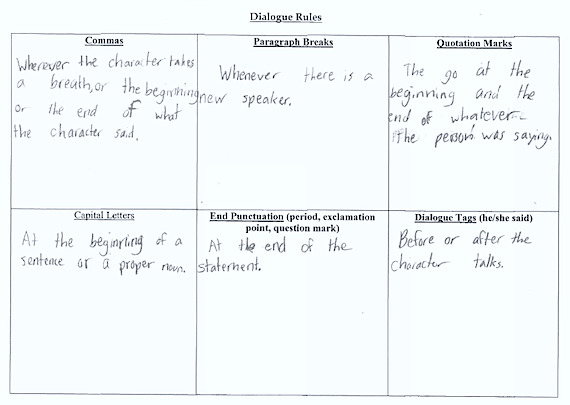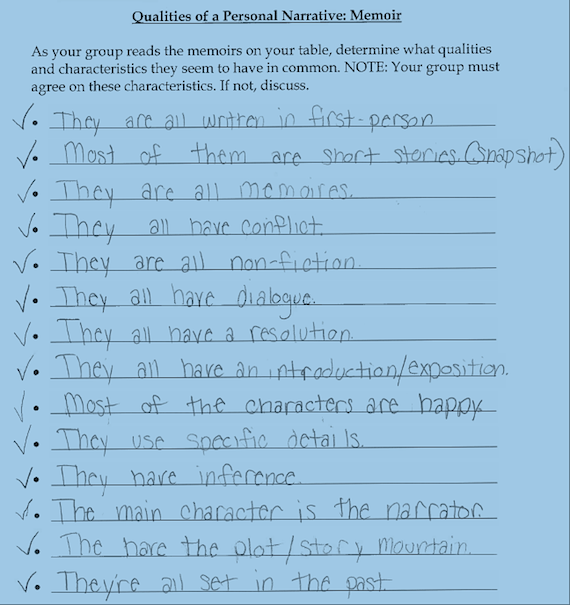Small Groups: Kids Often Learn Better Together
 At several professional development sessions I attended this year, the speaker reminded us, “The person doing the talking is the one doing the learning.”
At several professional development sessions I attended this year, the speaker reminded us, “The person doing the talking is the one doing the learning.”
This hits home for me because I am a constructivist at heart. It is one of my core beliefs that adolescents need social interaction in order to engage with the material. The process of discovery cements the learning.
To that end, one of the instructional techniques I use nearly daily in my classroom is that of Gradual Release of Responsibility (the “I do, We do, You do” process). But I usually begin with the step: “You do together.”
I find that the students are very motivated by the challenge of “figuring things out” collectively and end up retaining the material better.
Collaborative inquiry works well with G.U.M. topics

Rather than going through a book, worksheet, or PowerPoint, I had the students open up their choice reading books to a page with dialogue. Working in groups, they explored the author’s presentation of dialogue and determined the rules of how to use commas, quotation marks, capital letters, paragraph breaks, and dialogue tags.
They compiled their responses in a chart as they went along. After they finished, we shared and groups added any missing information to their version of the chart.
Finally, I gave my student groups the actual rules for punctuating dialogue, and they determined which ones they had gotten correct (resulting in lots of cheering) and which ones they had overlooked (“oops”).
The culminating practice assignment was for each student to write a properly punctuated conversation between themselves and another person (real or fantasy/positive or negative) – with each person speaking at least three times. They were all fully engaged in writing their conversations, and feedback from the students was that the assignment was great fun.
Other ways we “do it together” first
This same process works well with other topics such as capital letter or comma use, but I also use this technique for lessons beyond G.U.M.
For example, last week I distributed a stack of eight brief memoir mentor texts to each group. Working together, they each read a couple and then attempted to determine the commonalities between the texts.
I was pleasantly surprised at their sharing and rich discussion, and the resulting lists of qualities and characteristics of personal narratives they compiled were impressive.
They hit the nail on the head and I didn’t have to lecture once. I am excited to read what they write as a result in their own memoirs.
Well behaved and engaged
Over the years of using this technique, I’ve found that I have very little disruptive classroom behavior because students know they will be given a “legal” outlet for their need to socialize.
Best of all, they are more engaged in learning the material when they discover it for themselves rather than passively absorbing the information. And collaborative constructivism can be adapted to any subject matter, making it an ideal 21st century teaching practice.
Cheryl Mizerny is a veteran educator with over 20 years experience–primarily at the middle school level. She began her career in special education, became a teacher consultant and adjunct professor of Educational Psychology, and currently teaches sixth grade English in Bloomfield Hills, Michigan. Her teaching is guided by her belief in reaching every student and teaching the whole child: socially, emotionally, and cognitively. She writes a blog about student motivation and engagement at The Accidental English Teacher.








































I’m always looking for engaging lessons to teach proper mechanics and this really helps. I am an intervention specialist and I see the value of group work, but struggle with finding ways to get students to take their talking turn. I’ve recently started group work by requiring all students to take turns talking at the beginning and again at the end to sum up their learning. It was very hard for some of my students the first 2-3 times, but talking definitely helped them value group work. Thanks so much for your idea!
Thanks so much for your ideas, I am definitely going to try this in my next narrative unit. Can you please give the list of memoir mentor texts you used?
These are great ideas. I want to let go more, but I keep talking more and more. Thank you for sharing. Deborah
Love the ideas you presented here – and for grammar instruction! As a coach, I find it hardest to find ideas for constructivist activities that teachers will accept. They often push back with, “I learned it this way. Why can’t the kids?” My response is that probably 60% (according to some sources) learned grammar with exercises and activities like we’re used to, but 40% couldn’t learn that way. Obviously. Check the spelling and grammar of posts. So, thank you for sharing. Please continue.